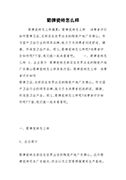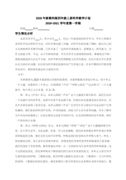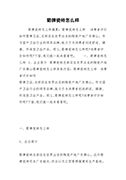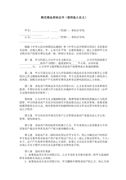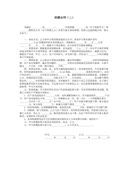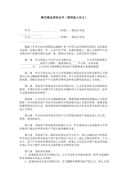牛津小学英语4A Unit6 Whose gloves?(精选3篇)四年级英语教案
牛津小学英语4A Unit6 Whose gloves?(精选3篇)
牛津小学英语4A Unit6 Whose gloves? 篇1
一、教材分析:
本课选自《牛津小学英语4a》中的unit6。这套教材从视听入手,注重听说训练,着重培养学生的语感和初步运用英语进行简单日常交流的能力,通过听、说、读、写、唱、游、演、画、做等活动激发学生的学习兴趣,帮助学生养成良好的学习习惯,形成有效的学习方法,发展自主学习的能力,为进一步学习打下基础,书中的各单元内容贴近学生的生活和学习实际,unit6的核心教学内容是“寻找物主”,要求学生围绕服饰类的单词,在一定的情景下,能正确使用 whose is this/are they?进行交谈,并能对物体用形容词big. small. long .short来进行描述,并能灵活运用,基于此,结合本单元a. read and say , b. look. read and learn的内容较多,故选a中的1、2、3幅图和b中的部分单词安排在第一课时教授。
二、教学目标:
1、认知目标:
(1).能听懂、会说、会读和会拼写单词big. small. long . short . sweater. jacket. whose。
(2).能正确地听、读单词a pair of jeans .a pair of gloves。
(3).能听得懂、会说和会读日常交际用语the is /are too……try this one/pair on 。能初步运用whose 来进行简单问答,回答’s。
(4).初步理解掌握服饰类单词中复数单词的形式和用法以及与动词be和代词用时的一致关系。
2、 能力目标:使学生能熟练地应用本课所学的语言知识,进行日常交际,形成综合运用语言的能力。
3、 情感目标:以情感培育人,以兴趣吸引人,通过引导学生参与游戏、表演,对话等丰富多彩的教学活动,营造一种轻松愉快的教学氛围,让学生充满乐趣地学习,并从中获得美感。
三、教学方法:
1、 直观情景教学法:本课将通过实物(服饰、其它物品等),创设出一些语境,让学生体验语言的真实,自然及语言的交际功能。
2、 整体语言教学法:本课通过实物的演示,让学生试穿服装,去体会big. small. long. short的含义,让学生进行整体感知,而非孤立地去死记硬背,从而学会说try this one /pair on 。
3、 活动式教学法:通过设计情景,采用多种多样的活动,围绕参加party去选择衣服这一内容,把书本知识融进活动中,让学生在活动中不断地吸收,内化所学知识。
根据小学生的特点,本课创建了活动为主的教学模式,重点培养学生运用英语进行简单交流的能力,通过听、说、读、演、玩的形式,鼓励学生积极参与,大胆表达,提高学生对语言的感受和运用英语进行日常交际的能力。
4、教学过程:
(一)、组织教学:
1、 师生交流,通过师生相互问好,演唱歌曲“we are happy bees”,营造一种轻松的学习氛围,学生可以边唱边表演,这样就很快进入一种自觉的语言状态,
(二)、复习引入:
通过一些实物,学生比较喜爱的如balloon. apple等,用以前学过的what’s this /that in english? do you like……?is it nice?等这样的问答自然地带出以前听学过的“big . small. long. short”,如教师可说:do you like balloons? i have some big ballons here’s a big balloon for you.等。
(三)新授:
教师展示一下自己的漂亮衣服,告诉学生今天要去参加一个生日party,询问有哪些同学愿意一起去?用这一活动来引起学生的兴趣,让他们处于一种兴奋状态,全身心地投入到学习中去,这时教师可让一个学生上讲台,帮他打扮一下,例如梳头等,整理衣服等,然后自然地引出:your sweater is too long. do you like a new one? s: yes. t : please take it off.帮助学生脱下sweater,指着一件毛衣说:try this one on.学生穿上后,教师可指着远处的一件说:oh. it’s too small. try that one on 自然地引出了单词sweater. small. 出示图片,让学生认知,体会too……让学生学会评价it’s too……,教会学生用try this one on .同样的方法可以教big .jacket,利用hat. coat. dress等,创设类似的情景,让学生做替换练习,让学生在真实的情景中理解句子的含义。
(2)教a pair of shoes .the shoes are too…….try this pair on 时可以穿插long .short 这对反义词进拼读训练,例如:教师可让一男生上台,对他说i have a pair of shoes .do you like this pair? here you are. try this pair on.引出a pair of shoes 进行认读,当学生穿上太大时,教师可说:the shoes are too big. try this pair on.同样的方法可以教会学生用a pair of jeans进行替换训练,引出“long .short”这对反义词,进行认真拼写训练,并在真实的情景中学会说try this pair on。
(3)这时教师可带着已打扮好的学生去birthday party。开门后教师装出冷的样子,退回教室说:oh, it’s so cold. i need to put my gloves on。教会学生认读单词a pair of gloves ,并让学生回座位戴手套,学生可能没带,向同学借了后,教师可问:the gloves are too big .whose gloves?可启发式地问“’s?”让学生明白并回答“’s”,这时就可出示新单词whose进行拼读训练,可用其它物品进行替代练习,whose……?’s。在此可穿插一个“猜物主”游戏,教师拿出事先准备好的物品,当学生拿到手中的物品时,全班学生问:whose……?让其回答’s。猜对了,教师可给予奖励,大家一起说“try this one on”“ try this pair on.”待其穿好后进行评价it’s too ____, the___ are too____。
(4)教师在游戏后可以演示一段多媒体,内容为某位学生的birthday party场景,看完以后让学生回答whose birthday?这时教师出示挂图,告诉学生su yang and su klai也去参加birthday party,让学生听录音,听听他们的谈话内容,回答教师的问题:
1、i’s su hai’s dress small?
2、are su hai’s jeans long or short?
3、where are they?
然后让学生跟读、齐读、并表演。
(5)操练巩固:教师通过询问,哪些同学也愿意参加birthday party,教师说:“let’s do some shopping to buy some new clothes then go to the party。”引导学生进入一个购物情景,综合运用以前所学的句型进行对话表演,教师可与一学生示范。如:can i help you? what would you like? i’d like ___ , do you like___ ? it’s too ___. the ___are too ___. try this one /pair on. how much is it /are they……?进一步发展他们的口头表达能力,最后可以小组以单位进行比赛,各派一名同学上台购物并当场试穿,全班同学进行评价,选出最佳服饰仪表奖,然后教师带了他们拿着礼物说:now let’s go to the party。
五、布置家庭作业:
1、听磁带有感情地朗读unit6中的1.2.3.幅图。
抄写单词long .short . big. small. whose .sweater. jacket及句子it’s too small. try this one on the jeans are too long . try this pair on。
2、以四人为一组,编写对话并表演。
六、板书设计
unit6 whose gloves?
a sweater small it’s too small.
a jacket big try this one on
a pair of jeans long the jeans are too long .
a pair of gloves short try this pair on
本课小结:
本节课围绕参加birthday party展开活动,让学生自己挑选衣服,精心打扮,并给以评价,在真实的情景中,教学层次分明,过渡自然,紧扣教学内容,使学生在真实的情景中直观学习,加深印象,激发学习兴趣,培养他们学习英语的积极态度,启迪思维,使他们成为学习的主体,并在学习中受到了美的教育。
牛津小学英语4A Unit6 Whose gloves? 篇2
一.教学目标
(1) 知识目标
1. 能听得懂,会说,会读和会拼写单词:a sweater, a jacket以及a pair of shoes
2. 能听得懂,会说,会读单词:a scarf, a pair of socks, a pair of gloves
3. 能听得懂,会说,会读和会写句型whose… is this/are they? it’s/they’re….
4. 能掌握服饰类单词中复数单词得形式和用法以及与动词be和代词连用时的一致关系
5. 能理解’s的含义
(2) 能力目标
1. 能运用所学语言寻找物品的主人
(3) 情意目标
1. 捡到东西要还给别人
2. 自己的东西要看管好
一.教学重点
1. 能按三会,四会要求掌握本课单词,句型。
二.教学难点
1. 服饰类单词单,复数的形式与用法以及与动词be和代词连用时的一致关系。
三.教学准备
单词卡片,服装,课件等。
四.教学过程
(一)greetings
(二)free talk
t: today, i’m very happy. so i’m wearing some new clothes. look at my new sweater.
ss: it’s nice!
t: thank you.
(三)play a game(用游戏的形式复习以前学过的服饰单词)
t: now let’s paly a guessing game
what’s this?
ss: it’s a ….
(四)presentation
(1)呈现 a jacket, a sweater, a scarf以及句型whose…is this?
1. t: you lost a lot of clothes last pe lesson. i picked them up and took them here in this box. look, what’s this?
ss: it’s a jacket. (spell it)
t: yes, this is a jacket. (show the sentwnce)
1. read it 2. show: this is+ 单数 (a…) 3. make sentences
t: this is a jacket. is this your jacket?
s1: no, it isn’t.
t: is this your jacket?
s2: no, it isn’t.
t: whose jacket is this? (repeat) please guess.
you may answer: “perhaps it’s ’s. it’s ’s, i think.”
s: perhaps it’s ’s.
t: look, it’s ’s. (show: it’s ’s.)
t: whose jacket is this?
s: it’s ’s.
show: whose(read and spell)
show: whose…(jacket) is this? (read)
s1: whose jacket is this?
s2: it’s ’s.
practice.
t: , is this your jacket?
s1: yes, it is.
t: here you are. don’t forget next time.
2. t: look, whzt’s this?
ss: it’s a sweater. (spell it)
t: let’s ask together.
ss: whose sweater is this?
s1: it’s ’s.
t: look, it’s ’s.
ss: , is his your sweater?
s: yes, it is.
ss: here you are.
t: thank you.
3. t: this is a scarf.(read)
boys: whose scarf is this?
t: perhaps, it’s ’s.
girls: whose scarf is this?
t: perhaps, it’s ’s.
(2)呈现 a pair of shoes, a pair of socks以及a pair of gloves
1. t: look, this is a shoe. (read)
here’s another shoe. two shoes.
two is a pair. means a pair of shoes
they are shoes.
show: theythey are shoes.(read)
show: they are +复数
make sentences.
t: they are shoes. whose shoes are they? guess. you may answer “ they’re ’s.”
show: they’re=they are
2.t: they’re shoes and socks.
show: a sock, socks, a pair of socks.
t: whose socks are they? let’s ask the tv together.
ss: whose socks are they?
s1: they’re ’s.
3.t: look, this is a pair of gloves.
show: glove, gloves, a pair of gloves.
t: read the title
s1: whose gloves are they?
s2: they’re ’s.
practice in pairs.
(五)consolidation
1. paly a game
2. do the puzzle
3. write the sentence
(六)homework
1、copy the four-skilled words four times.
2、practice the new sentences with each other .
牛津小学英语4a unit 6 whose gloves? (b和c部分) 来自98e范文网。
牛津小学英语4A Unit6 Whose gloves? 篇3
教学目标:
1.three skills: big 、small、 long、 short、 try this one\pair on. whose…is this\are they? it’s\they’re…it’s too…
2.two skills: so funny、 she looks so funny.
3.能理解名词所有格的用法。
4.通过创境游戏等活动培养学生在句中学词,在交际中运用的能力。
教学重点:目标1
教学难点:whose… is this\are they?及其答句的区分。
教具准备:录音机、实物、图片、投影仪
教学设计:
step1 revision
1.学生说歌谣:服装衣帽名称。
2.revise the greetings.
the way: 整体问答
3.复习服装类单词。
the way: 运用图片,进行整体到个别的答问练习,再随机谈论同学的服装。
step 2 presentation
1.出示课题
2.teach: gloves
the way: 运用实物、图片进行教学,并渗透语音教学。
3.随机教: big、small
4.teach: jeans、short、long (in the same way)
step 3 presentation
1.呈现并教学: whose… are they? they are…
the way:
(1)师拿手套自问自答:whose gloves are they? they are my father’s. whose jeans are they? they’re miss yang’s. 再用学生的学习用品问,让学生学会说答句:they’re…
(2)再呈现问句:whose… are they? 领读、分组读、分行读
(3)师问生答、生问师答
(4)pair work
2.teach: whose… is this? it’s …
the way: 师故意拿一单数物品让学生提问,纠错过程中呈现并操练。
3.play a game:猜物主
4.呈现并教学:try this one on. try this pair on. it’s too … they are so … so funny
he\she looks so funny.
the way:
(1)创设到商店买服装的情境,与两生示范。
(2)跟读新句子。
(3)practice in threes.
(4)act out.
step 4 practice
1.look at the picture, listen to the tape and repeat.
2.read after teacher then practice in pairs.
3.check several pairs.
step 5 consolidation
1.出示投影片,读对话,仿照编对话。
2.三人一组练习。
3.act out.
4.根据所给情景编演对话(三人组)
林林和芳芳上学路上看见一个穿着滑稽的男孩,原来还是她们的同学。请你用上今天所学的句子仿照刚才所读的对话编演新对话。
设计思路:
本节课的内容是第六单元的第一课时,重点是询问物主:whose…is this/are they?及其应答,另外还要学习一些服装类单词gloves,jeans及形容词big,small,long,short;try this one on/try this pair on.为了合理地组织课堂教学,体现新课程的理念,我设计了如下几个步骤:
1.复习时首先安排say a rhyme,说说破服装衣帽名称,再运用图片从整体到个别复习服装类单词,谈论同学的穿着,这样安排使学生迅速进入学习英语的情境,同时唤起并加深学生的记忆,为新课的展开作了很好的铺垫。
2.呈现课题时因势利导学习新单词gloves,自然过渡,单词教学注重直观(用实物),形容词教学时注意对比,big/small,long/short同时呈现,并用图片替代中文板书,为的是让学生根据事物形象直接用英语思维。呈现句型时先让学生学会说答句,再说问句,遵循先听后说的原则,听清楚了再说,说上口了再认,这样低点子、小步子分步呈现降低了难度,安排猜一猜的游戏是为了巩固所学的新句型,也调节了一下学习气氛。新课程中强调教学情景要与学生的生活实际相联系,要以教材为主体,把生活引进课堂,因此我教try this one on/try this pair on时,设计了学生都熟悉的到商店买服装的情境,让学生在真实的情境中通过老师的体态语言体会句子的意思,然后以任务型的方式编演对话,再大组派代表表演,这样增强了学生的竞争意识与合作精神。
3.练习时让学生看图听课文模仿发音,注重语音、语调的训练,培养学生的语感,再运用多种方式操练对话,达到自如运用的目的。
4.鉴于本课知识容量多、信息量大的特点,串连句子编对话显得难度较大,我利用投影呈现了一段对话,让学生有一个参照,降低了难度,提高了学生的参与率。新课标要求教师要以课堂教学为续点,向课外延伸,因此我又设计了一个情景,要求学生用上今天学过的新句型编演对话,这样做延伸了新知识,达到了让学生在生活中学会运用英语的目的。


